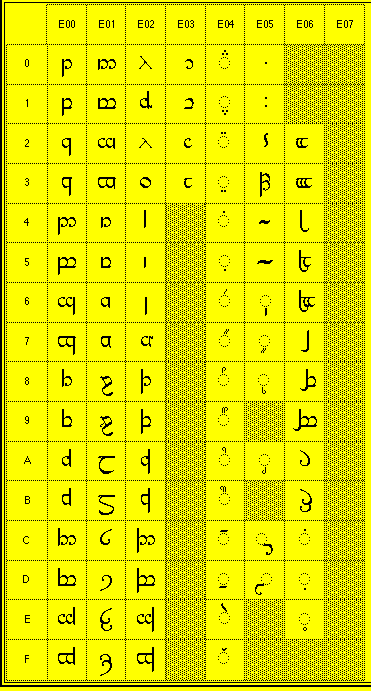|
Het "Klingon" schijnt het voorlopig niet te halen maar
het "Tengwar" resp. het "Cirth", en recent het
"Shavian" resp. "Nushu" gooien hoge ogen:
Tengwar en Cirth hebben iets met J.R Tolkien van doen, Shavian met
George Bernhard Shaw resp. de mormonen van Brigham Young en Nushu
[nieuwe schoenen] met een Chinees vrouwen-taaltje, oneerbiedig gezegd
en gezwegen.
[Ken Whistler]
Some, like Tengwar, have taken a somewhat different path. Tolkien
constructed it for aesthetic and literary purposes, and certainly
never had the intent of someone like Shaw, to use it for the reform or
replacement of an existing orthography. However, unlike Shavian,
Tengwar has had a kind of organic success of a sort, spreading in its
aesthetic and literary realm, and gaining a group of adherents. The
fact that Tengwar is used to express a language that itself was also
consciously constructed does not, as I see it, render it any less
suitable for the purposes it is intended and used. After all, the
Latin script is also used to express constructed languages such as
Esperanto. I see no *moral* distinction here, even if Tengwar is more
often put to the purpose of writing romantic nature poetry, whereas
Esperanto tends to discussions of world government. ;-)
And as I have said before, I see nothing inherently less
worthwhile in a well-constructed Elvish poem expressed in Tengwar than
in a warehouse record from Uruk expressed in Sumero-Akkadian
cuneiform.
| |
[Doug Ewell]
I do feel that there is a difference between:
(a) scripts like Shavian and Deseret, which were invented in a
completely serious vein, in an attempt to provide an alternative and
presumably better means of writing a real language, but didn't quite
catch on; and
(b) truly "fictional" scripts like Klingon, Tengwar,
Cirth, and such that appear in novels or TV or movies and were never
intended to be used seriously.
Both G.B. Shaw and the Mormons had genuine, if not universally
shared, reasons for wanting to abandon the Latin script for writing
English in favor of something "better." Shaw thought English
literacy could be improved with a more regular writing system to take
the place of the convoluted Latin-based orthography. (There are also
rumors of darker motives, but the intent was still for serious use.)
Brigham Young wanted to isolate the Mormons from the rest of the
"corrupt" world of written English.
[Tom Emerson, senior Sinostringologist]
William Chiang(*) provides a table of some 1535 nushu glyphs, with
possible hanzi originals and hanzi glosses for each nushu glyph.
His table is built from 141 documents covering 13 registers and
containing some 107K glyphs. The oldest texts analyzed date from the
beginning of the 20th century: older texts are much more difficult to
come by because a woman's writings were often burned after her death.
The texts range from a number of different authors.
I don't have a break down of the number of glyphs and each
variant, though I've been meaning to do this for a while.
There is still active research being done on cataloging and
categorizing the nushu writings, though this information is available
only in Chinese, is published only in China, and has not been
computerized.
I've been meaning to develop a proposal for nushu for a while, but
have been stalled creating the fonts.
(*) Chiang, William W. "We Two Know The Script; We Have
Become Good Friends: Linguistic and Social Aspects of The Women's
Script Literacy in Southern Hunan, China". University Press of
America, 1995.
|

